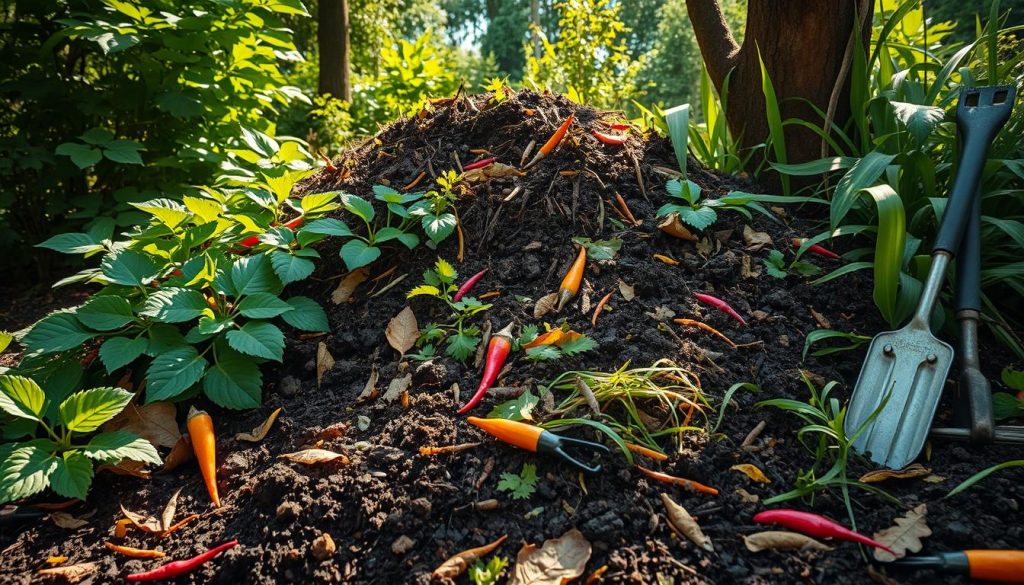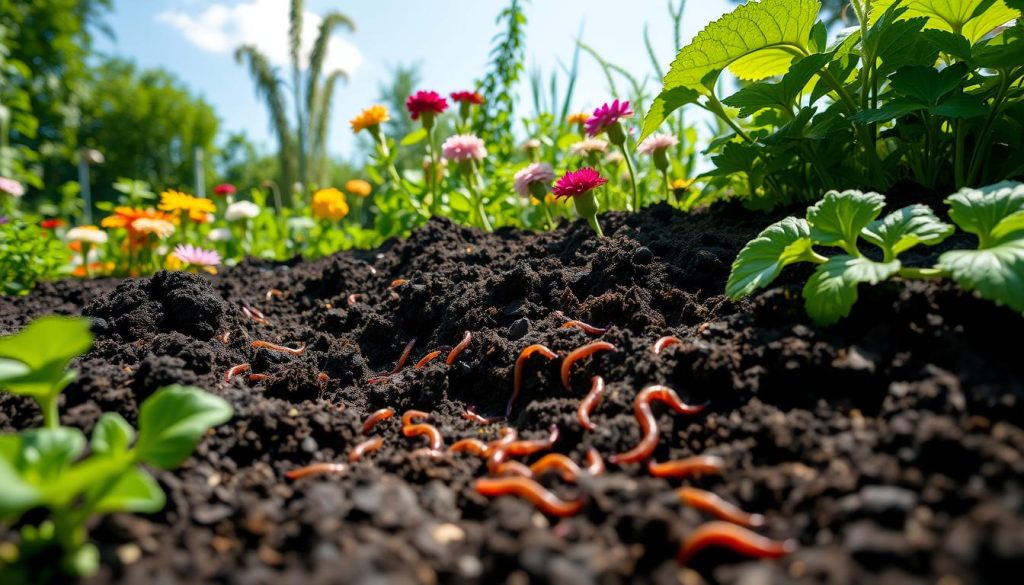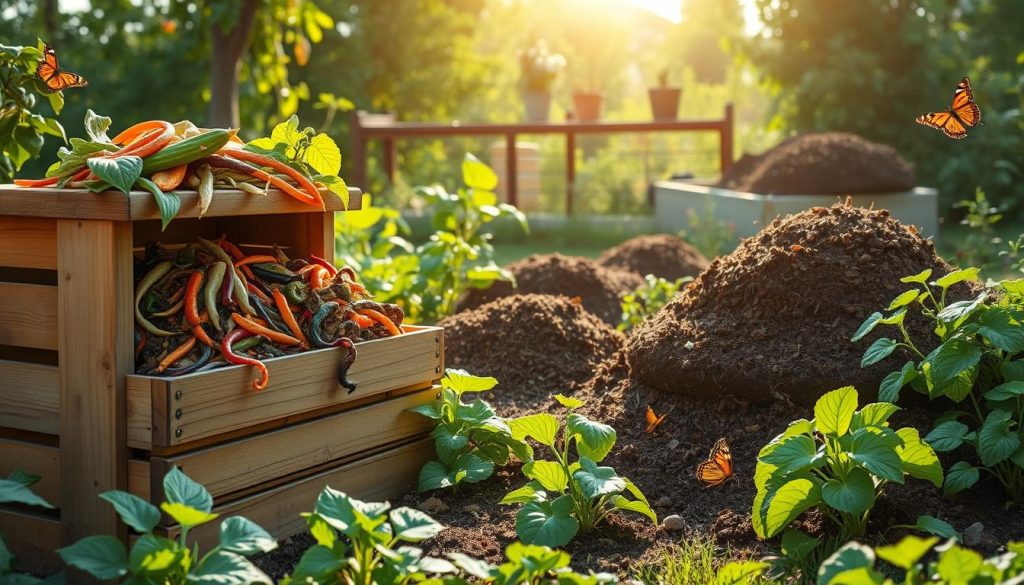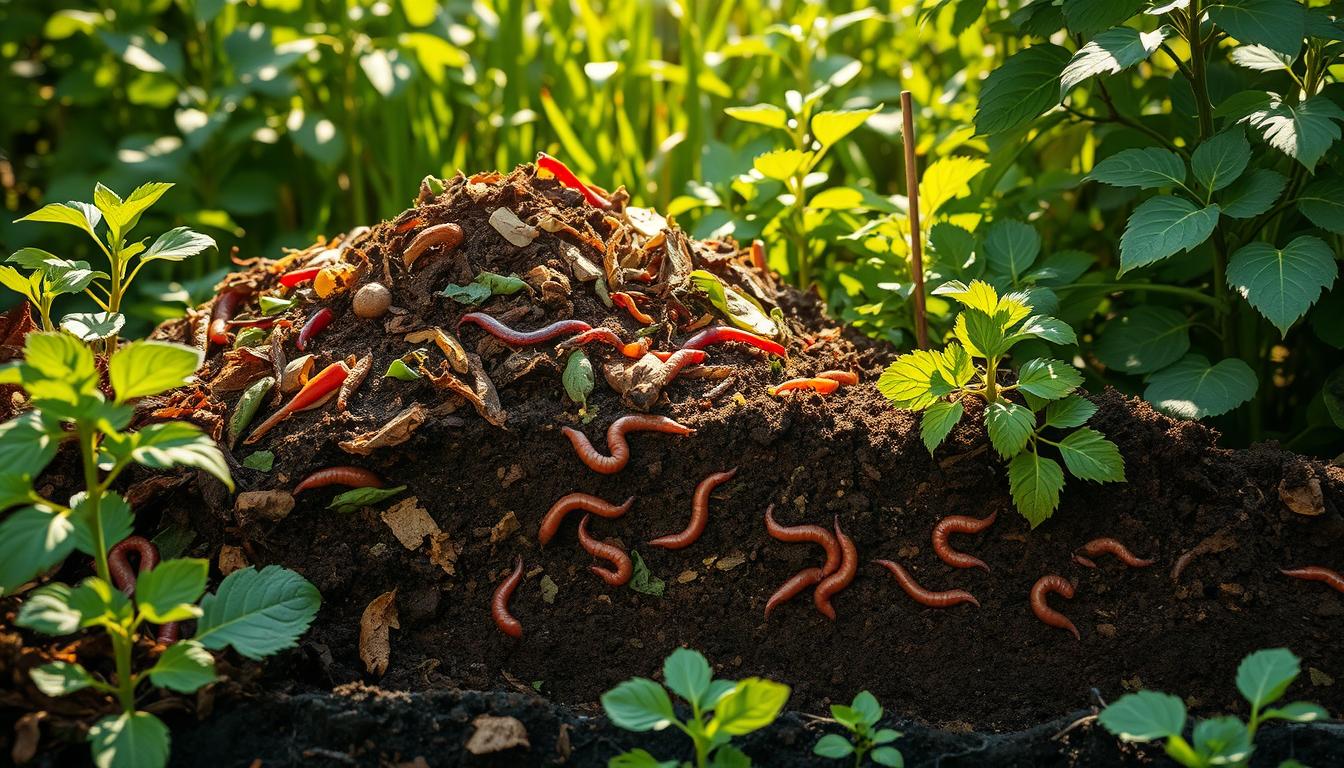I’m excited to share my journey with composting and its many benefits for soil health. Composting breaks down organic materials into a nutrient-rich soil amendment. This can greatly improve soil fertility and reduce waste. By composting, we can create a sustainable gardening solution that helps the environment and unlocks composting’s full potential.
Composting has many advantages, like improving soil structure and boosting microbial activity. These are key benefits that help plants grow healthy.
In this article, I’ll explore how composting can change your garden. I’ll share insights into composting and soil health. We’ll see why composting benefits are so important for our environment.
My Journey into Composting
I started composting to lessen my environmental impact and make gardening more sustainable. I learned about balancing green and brown materials, keeping moisture right, and ensuring air gets in. This knowledge helped me make a rich soil amendment for my garden.
My research showed composting is a smart way to cut down on waste. It turns food scraps and yard waste into something valuable for my garden. Key benefits include:
- Less greenhouse gas emissions by reducing landfill waste
- Less water use by improving soil’s water hold
- Healthier plants with essential nutrients
As I learned more, I saw composting’s big role in managing waste and making gardens healthy. 
Benefits of Composting for Soil Health
As I delve deeper into composting, I’ve seen its many benefits for soil health. Adding compost to my soil has made my garden more sustainable. It helps plants grow well and cuts down on the need for harmful fertilizers. This has made my garden’s ecosystem better overall.
Some of the key benefits of composting for soil health include:
- Improving soil structure, allowing for better water retention and aeration
- Enhancing nutrient levels, providing essential nutrients for plant growth
- Boosting microbial activity, which helps to break down organic matter and fight plant diseases
By composting, I’ve made my garden a thriving, sustainable place. It’s not just good for my plants; it’s also better for the planet. I’m eager to keep learning and improving my garden’s health and sustainability.

Composting has truly transformed my garden. I strongly suggest it to anyone wanting to improve their soil and garden health. It’s easy to do and offers many benefits, making it perfect for gardeners of all levels.
The Composting Process I Follow
Exploring composting, I’ve learned its value. It makes compost that boosts soil health and helps the environment. I mix green and brown materials for a balanced compost.
I pick the right stuff like food scraps, leaves, and grass clippings. These are full of nutrients and create a rich compost ecosystem. I keep the pile aerated and check moisture to help microorganisms break down the materials.
Key Steps in My Composting Process
- Collecting and sorting materials: I separate green materials (food scraps, grass clippings) from brown materials (leaves, twigs)
- Creating a balanced mix: I aim for a mix of 2/3 brown materials and 1/3 green materials to ensure optimal carbon-to-nitrogen ratio
- Monitoring moisture levels: I check the compost pile regularly to ensure it’s not too dry or too wet, as this can affect the microorganisms’ activity
By following these steps, I make compost full of good microbes. This compost makes soil better and helps the environment by reducing waste and supporting green gardening.
Tips for Successful Composting
To make great compost, you need to follow some key steps. These steps help you create compost that’s full of nutrients. It’s perfect for gardening in a way that’s good for the planet. I’ll share my best tips to keep your compost balanced and avoid common mistakes.
Composting is all about mixing green and brown materials. This mix is key for microbes to grow. Aim for a carbon-to-nitrogen ratio of 25:1 to 30:1. You can do this by using 2/3 brown stuff like dried leaves or shredded newspaper, and 1/3 green stuff like food scraps or grass clippings.
Avoiding Common Mistakes
Don’t add too much water to your compost. It can make it too wet and bad for microbes. Also, make sure to mix everything well. This helps everything break down evenly.
Stay away from adding meat, dairy, and oils. They can attract pests and make your compost smell bad.
Maintaining the Ideal Carbon-to-Nitrogen Ratio
To keep your compost balanced, watch what you add. Start with 2/3 brown materials and 1/3 green materials. You can also use a compost starter or accelerator to speed things up.

By following these tips, you can make compost that’s great for your garden. Always stick to the right composting techniques for a successful composting journey.
How Composting Transformed My Garden
Composting has changed my garden for the better. My plants are now healthier and more vibrant. This is thanks to the compost I add to the soil. It’s full of good microbes, which is key for soil health.
My plants grow faster and stronger. They fight off diseases better and give more food. I’ve also seen more bees and butterflies visiting my garden. They love the variety of plants and flowers.
Visible Changes in Plant Growth
Here are some big changes I’ve seen in my plants:
- They grow faster and produce more
- They’re healthier and fight off diseases better
- They have more colorful flowers and leaves
Attracting Beneficial Wildlife
My garden is now a home for helpful wildlife. This includes:
- Bees and butterflies, which pollinate plants
- Good insects like ladybugs and lacewings, which eat pests
- Worms and other tiny creatures, which help break down organic matter and make the soil richer
Overcoming Challenges in Composting
As I kept composting, I hit many bumps. Dealing with bad smells and pests was tough. But I was set on solving these problems to keep my garden green.
To tackle these issues, I took a few steps. I balanced my compost with green and brown materials. This cut down on odors and helped good bugs thrive. I also made sure my compost was well-aired to speed up breakdown and fight pests.
Dealing with Odors
Odors were a big problem for me. To fix this, I layered finished compost or soil on top. This soaked up bad smells. Regularly turning the pile also helped by adding air and speeding up decomposition.
Managing Pests
Keeping pests away was another battle. I added a bit of finished compost or worm castings to attract good bugs. Covering the pile with a tarp or plastic sheet also kept pests out and kept it warm.
With these strategies, I beat the composting challenges. I built a healthy compost pile that helped my garden and supported my green gardening ways. With patience and effort, anyone can do the same and enjoy composting’s perks.
My Favorite Composting Resources and Tools
I love composting and have found many great resources and tools. These include books and equipment that help me make rich, organic soil. They are key to my success in composting.
Recommended Books and Guides
“The Vegetable Gardener’s Bible” by Edward C. Smith is a favorite of mine. It’s full of tips and techniques for composting. Another great book is “Compost Gardening” by Barbara Pleasant. It explains the science of composting and how to use it in your garden.
Useful Composting Tools I Can’t Live Without
Some composting tools are essential for me. My compost tumbler by GEOBIN makes mixing easy. I also use a long-handle pitchfork from Fiskars to turn the pile. A good compost thermometer is a must for the right temperature.
These resources and tools help me create a sustainable composting system. They make a organic soil amendment and help the environment. I suggest everyone check them out and use them in their composting.

